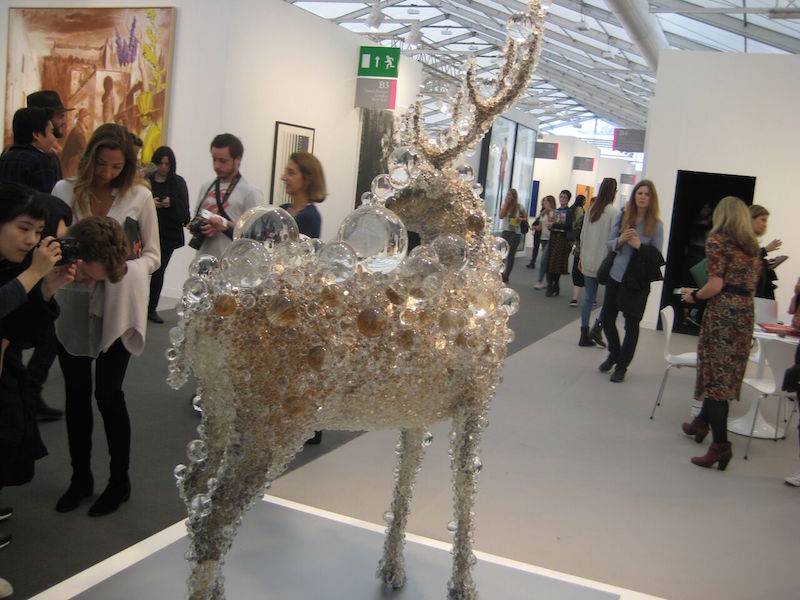Never previously have the Frieze Art Fairs here in London seemed larger, grander, or surer of their place in the universe of contemporary culture.
Looking round when one visited them, there seemed to be plenty of reason for this self-confidence. The main Frieze Fair was more spaciously laid out than I remember it being in previous years. It needed to be, as it was also absolutely thronged with visitors, of every generation, from the elderly hobbling on sticks to toddlers in their pushchairs. It was clear that for large numbers of people, a visit to Frieze had become a necessary annual rite, a way of saying to oneself, and of demonstrating to others, that one was fully integrated, a paid up member of the visual arts consuming elite.
It’s worth stressing the phrase ‘paid up’. Though there were certainly a large number of free tickets available, it’s likely that the majority of visitors had to pay to get in. In this respect, Frieze, like all art fairs, differs from the London public museums that enthusiastically offer contemporary art for mass consumption. There you pay for some things – their much-publicized temporary exhibitions – but what’s in their permanent collections comes for free.
Frieze, of course, is also ‘contemporary’ in a very strict sense. It lasts for less than a week, whereas museum shows last much longer. Blink and you miss it.
The paradox is that it is in some respects more ecumenical – one might even venture to say more democratic – than museum rivals. The main show gives a very good idea of what the international contemporary art world is up to, whether for better or for worse. Maybe one of the most striking things about it was the absence of ‘real painting’, in the traditional sense of that phrase. Particularly of figurative paintings. There were two rather nice, but very small – the size of a piece of A4 typing paper – paintings by Peter Doig, plus, elsewhere, a full-size copy of Manet’s Olympia. I suppose, in this context, one must describe it, not as a copy, but as an ‘appropriation’.
Elsewhere there was a painting with overlapping versions in gold of Jacques-Louis David’s Marat Assassinated, done in a style that paid homage to Andy Warhol’s paintings using stencilled photographs of Marilyn Monroe. Well, Marat and Marilyn were both stars in their different epochs weren’t they, and their names also both begin with ‘M’.
The most striking work on view and one that certainly drew the crowds was a huge kitsch assemblage of dressing table objects, all of them in pink, all made of plastic, by Portia Munson. This was curtly entitled Pink Project: Table 1994-2016.
Nearby, with a different gallery, there was a white porcelain vase in the shape of a life-size head of Karl Marx, with a droopy pot plant growing out of it. Some important opposing aspects of contemporary society were thus neatly covered, all within a few steps of one another.
Pink was certainly a theme at the main Frieze. Another conspicuous example was a huge curved shiny sculpture by Sir Anish Kapoor, which attracted a lot of visitors wanting to make selfies. The concave mirror surface had the great advantage of making anyone who stood squarely in front of it look fashionably thin.
Apart from the two Doigs, which would have found a place without difficulty in any fashionable boudoir, it was often hard to think what the fate of most of the art works one was looking at might be once the Fair was over. Though the event seemed to address itself to people with money jingling in their pockets, rather than to po-faced official institutions, it was hard to imagine living with most of the things on offer. The Kapoor, perhaps, might look well in the entrance foyer of an extremely grand hotel, casting a rosy glow over the comings and goings of its wealthy patrons.
The Frieze Masters Fair was necessarily different, though here, too, the emphasis was chiefly on the contemporary. There were a number of stands that spot-lit the work of artists who deserve somewhat more notice than they have till now been given. A good example was the compact display of work by Nancy Grossman, presented by Michael Rosenfeld, her New York dealer. Her fetish heads, covered in black leather, are haunting objects, and she is a gifted draughtsman – or maybe I should now tactfully say ‘draughtsperson’. The special display devoted to her was evidence of the increasing attention being paid to formerly somewhat marginalised women artists.
Apart from that there were some dealers with high-quality antiquities (but nothing to make a great museum cry its eyes out), and – my favourite thing in either Fair -a little head-and-shoulders portrait made by Géricault of the youthful Delacroix. Yes, God and the spirit of the contemporary forgive me, I really coveted that.
Words and photos by Edward Lucie-Smith

